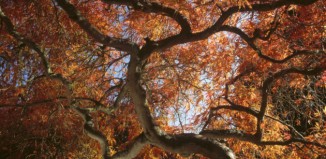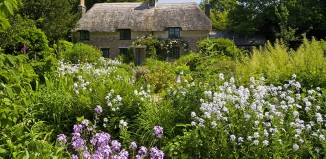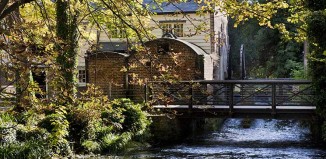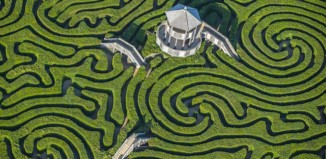Savill Garden
Savill Garden comprises 35 acres of interconnecting gardens and woodland and forms part of the Royal Landscape, a collection of gardens and parks spread across 1,000 acres. The Garden was originally created by Sir Eric Savill in the 1930s, while he held the position of estate surveyor later to become Deputy Ranger of Windsor Great Park, under the patronage of King George V and Queen Mary. However, the outbreak of the Second World War meant that the garden remained uncompleted until the 1950s and it wasn’t until the 1970s that the site was expanded to much the same size as it is today. The garden’s development continued to be supported by Kind George VI and Queen Elizabeth as well as today’s royal family.
“The Duke of Edinburgh currently holds the title of Ranger of the Great Park and you’ll often see him riding through the park on his four in hand,” says Harvey Stephens, Head of Savill Garden. “The royal family continue to take a considerable interest in all that happens across the park and within the Savill Garden and are kept updated with any plans we have for further developments.”
The garden’s links to the royal family are alluded to through the Golden Jubilee Garden, the Queen Elizabeth Temperate House and a series of royal rose beds where you’ll find the Queen Elizabeth, the Royal William and the Catherine Rose.
“The Catherine Rose was bred especially for the royal wedding and this is the only place in the country where you can see a whole bed of them,” Harvey explains. “It was created as a limited edition and only a week after I secured the plants here, they were completely sold out.” In between the vibrant red of the Royal William and the peachy-pink of the Catherine Rose now lies an area set aside in readiness for the next generation.
Just around the corner from this royal family-tree of roses, visitors will find the relatively new Rose Garden that was officially opened by The Queen in 2010. This section of the garden was created by Andrew Wilson, a garden designer and judge at the Chelsea Flower Show. This was Wilson’s first public design which has since become award-winning. Here, a myriad of roses swirl around a central viewing platform that allows visitors not only to get a better view of the garden but to breathe in the heady aroma that rises up from the blooms below.
“We wanted to do something different from the more traditional, romantic rose gardens, so instead we have great belts of colour starting at the centre of the garden with deep plum-coloured roses graduating out through pinks to oranges and apricots to tie in with the surrounding boarders,” says Harvey.
Further plans to add the climbing Rose Bengal Crimson to the Rose Garden’s surrounding wall will add even more interest to this area, especially as this variety blooms almost the whole year round. “The bricks in the wall itself were actually recycled from bomb damaged buildings in London after the Second World War,” says Harvey.
Great thought and attention has been put into all the different areas at Savill which have been planted with the eye of an architect and the palette of a painter, as striking trees and grasses add a frame to the colour combinations of the plants they surround. Colour and architectural form have been carefully considered with plant combinations such as low-lying black grass interspersed with the slender shoots of brilliant-white snowdrops in spring and the rhubarb-red stems of dogwood add a rich colour contrast to their frosty surroundings in the winter.
The perfume of the garden also has a great impact on the senses with collections of magnolias and rhododendrons casting their sweet-scented petals to the floor, while honeysuckle and wisteria only add to the wonderful scent that laces and permeates the air in the summer.
However, some plants are known for their aroma for an entirely different reason. During spring the stream that winds its way through the garden is also lined with yellow skunk cabbages, a member of the lily family. “It’s called the skunk cabbage for a reason,” says Harvey. “Some plants are prized for their wonderful scent, but this isn’t one of them!” What it does do however, is add a wonderful lemon-yellow shimmer along the ringlet of water that leads your gaze through the different areas of the garden.
You can even venture into the New Zealand section of the garden where around 3,000 plants have been carefully arranged to replicate the habitat of their native country. The garden was first opened to the public in 2007 and was designed to build on the collection of native plants gifted to The Queen following a state visit to New Zealand in 1986. A number of plants were also gifted to the garden from a New Zealand display at the Chelsea Flower Show; rather than pay the cost of shipping the plants back to their native country many of the hardier species were sent to Savill Garden instead.
This area of the garden has also seen a new addition in the form of a set of sculptures by John Edgar that were officially opened by the New Zealand Olympic rowing team. The artwork is comprised of two large stone pieces: a standing compass stone in New Zealand basalt representing the universal points of the compass, and a flat survey stone carved with the markings registered on all trig stations in the UK, reflecting the concepts of journey and discovery inherent within the New Zealand Garden.
Savill Garden holds several national collections of plants as well as some rare varieties. Some are so rare that they are wired into the ground to try and dissuade any potential plant thieves looking to add to their collection. Although this method doesn’t manage to deter the garden’s resident pheasant that, as Harvey explained, seems to favour the rarer variety of plants among its dietary intake.
As well as being the perfect ‘all you can eat’ paradise for pheasants, the garden also creates a safe haven for a variety of other wildlife and insects. “The oak trees here are a great home for nesting birds as well as beetles and moths,” Harvey says. “We also have a pair of Egyptian geese which nest in one of the trees here. This can take people by surprise as you think of them as nesting by the water, but they actually nest in the treetops and you can sometimes see their young falling down to the ground! Though somehow they always manage to survive.”
It’s not just the wildlife that finds this garden a haven as visitors continue to flock through the garden gates year after year in order to admire the wonderful array of plants, picnic on the grassy areas or just sit in tranquillity and enjoy the sweet-scented surroundings. Those who work at the garden continuously strive to improve and build on the garden’s existing collections while adhering to Eric Savill’s original idea of creating a new and exciting area within Windsor Great Park for the public to enjoy.
“To continue inspiring visitors through each season we must keep the collections current and the garden’s appearance contemporary. To enable us to achieve this we have a ten year work programme for the maintenance and on-going development of the Savill Garden,” says Harvey. “I am sure it is this long term and cohesive approach respecting the gardens significant collections and key elements that are at the core of the garden’s flourishing success. Whilst we are stretching one foot firmly into the 21st century we have the other firmly planted in the past.”








